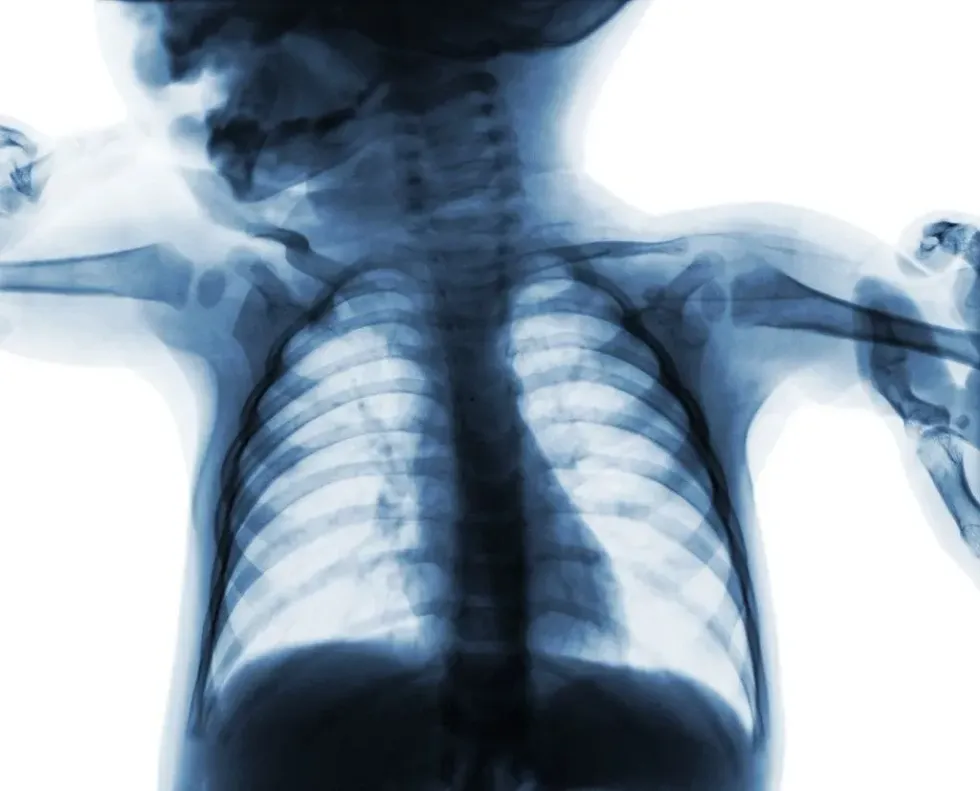Having an infant x-rayed may seem a little scary, but there's nothing to be afraid of.
The procedure is safe and painless. It's a vital test to diagnose a large range of potential health problems that can't be seen any other way.
The main difference between the adult x-rays you've probably had yourself and a baby x-ray is the type of restraint. While adults and older children can be relied upon to sit still for the camera, babies are sure to wriggle about.
Often, a special baby xray tube is used to hold the child still and capture sharper images. This can be alarming for infants (as well as unprepared parents! ), but carries no extra complications.
This article provides information on how to prepare young kids for an entire baby xray, the risks involved, and what to expect in the radiology room.
Find out all about newborn stomach size or why your baby has red under the eyes too, here on Kidadl.
What Is An Xray?
People have known about x-rays for a long time. X-ray radiation was first harnessed in 1895 by physicist Wilhelm Röntgen, who noticed that the rays could pass through soft material such as flesh, but not harder material such as bone.
He immediately realised that the rays could be used to photograph and study structures inside the body without the need for surgery.
It caused a revolution in medicine.
The technology was demonstrated on the battlefield just two years later during the Balkan War, providing images of bullets and shrapnel in wounds, and soon found its way into hospitals. The beams were called 'x radiation' (later x-rays) simply because they were a form of radiation that hadn't at the time been explained.
Despite the mysterious-sounding name, x-rays are really just another form of light. The radiation we see with our eyes comes at different wavelengths, which determine colour. Long-wavelength light is red, for example, whereas we perceive shorter wavelengths as blue. X-rays have wavelengths about 1,000 times shorter still, which is way beyond the range our eyes can detect.
A short wavelength is another way of saying 'higher energy', and that means anyone exposed to x-rays for a prolonged time is at danger of high radiation exposure. For this reason, any form of medical x-ray is kept as short and infrequent as possible.
An x-ray scan for babies takes a fraction of a second. The image is recorded either onto photographic film or, more commonly these days, digitally.
What Can They Help With?
The medical x-ray is among the most versatile and important tools for a doctor to discover what's wrong with a child. Most famously, an x-ray can quickly reveal broken or damaged bones on almost any part of the body.
Jaw x-rays are a routine part of many visits to the dentist. A chest x-ray can pick up conditions as diverse as pneumonia, tumors, damaged blood vessels and any objects that may have been swallowed or inhaled.
X-rays are an exceptionally good tool for diagnosis, helping a doctor to understand why your child might be breathing with difficulty or constantly coughing.
A doctor may also use x-rays as a quick method to diagnose problems in the abdomen, such as kidney stones, gallstones or blockages. Results are quick, and may be available within minutes of the scan, offering kids a rapid test of whether they need further care.
Are They Safe?
As mentioned, x-rays do come with a health warning. Too much radiation exposure can lead to burning, hair loss and even tumors. Smaller children are particularly sensitive to the radiation.
For this reason, the dose is carefully controlled. Your child will be given only a small exposure to radiation, focussed on the area of interest, with well-proven safeguards in place.
A single x-ray is of negligible risk, often likened to the increased radiation exposure from taking an airplane flight. However, if your child has to have numerous x-rays over time, then there may be a very small increased risk of cancer later in life. It is important to talk to doctors about these risks before giving consent.
Remember, x-rays have been used in medicine for over 120 years. Their potential effects have been studied intensively. Ways to limit-x ray radiation exposure have been perfected over many decades. This is a very old and reliable technology whose benefits may vastly outweigh the minimal risk.

How Do I Prepare My Child?
Rest assured, the pediatric centre will provide full information on how to prepare children for the x-ray exam. You don't actually have to do all that much in advance.
If your child is old enough to understand, you may want to talk through what will happen at the chest x-ray, and perhaps do a little role play to get then prepared for the special x-ray tube (see below).
Your child should wear loose, easily removed clothing for the exam. Any metallic objects such as hair clips should be taken off before the scan.
Some types of x-ray will require your child to swallow a 'contrast agent', which helps distinguish unusual structures from natural tissue. For this type of scan, it's helpful if the child does not eat or drink for a few hours beforehand. Again, the healthcare provider will provide full information ahead of time.
Although the scan will be painless, it can be a little intimidating. Basically, they're going to be inserted into a large plastic tube (see below), something they presumably won't have experienced before.
Parents may want to read up about this beforehand (and view images! ), because it does look a little weird. And bring along your child's favorite soft toy as a comfort and distraction for them.
What Will Happen?
The exact procedure will depend on the type of scan needed. For a simple baby hand xray, the child can usually be scanned using a standard device, using just a light restraint.
For a chest x-ray, however, babies and younger children need a special machine to ensure the radiation dose hits the right spot. Without restraint, they would inevitably wriggle around and blur the images.
Small kids are therefore placed in a special pediatric machine known as a Pigg o Stat. This is simply a large, transparent tube that holds the infant still and upright while the device takes the scan.
You'll be asked to remove their top beforehand. The child will be placed with their lower body resting on something like a bicycle seat, and their arms reaching up into the air.
Their reproductive organs will be shielded by a lead guard. As we say, it all looks a little bit weird!
Although the Pigg o Stat causes no pain or discomfort, children will often cry in distress at the strange experience. In a way, this a good thing as their deeper breaths will lead to a better quality x-ray image.
This type of baby xray machine has been in use since the '60s and has a long track record of safety and efficiency.
In most cases, the child's parent will be allowed into the room, to help keep things calm. If so, you will be asked to wear a special lead apron to further shield you from unnecessary exposure to radiation.
The radiologist will then leave the room, or move behind a screen to operate the equipment. The x-ray process should not take very long, and will cause no harm to your child.

What To Do Afterwards
The x-ray procedure should only take a few minutes. Afterwards, the radiologist will immediately unstrap your child from the baby xray holder. You'll then be able to hug and reassure your baby, and praise them for doing a great job! Images should be available almost immediately, though you may have to wait for results in some cases.
If you found this article helpful, then why not take a look at our advice to dealing with blocked tear ducts in infants, or what to do if your baby hates tummy time?










